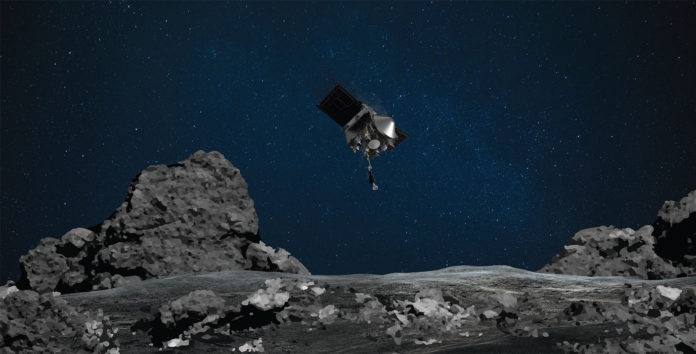Asteroid Bennu, which is more than 200 million miles (321 million kilometers) from Earth, offers scientists a window into the early solar system. The asteroid is believed to be a leftover fragment from the tumultuous formation of the solar system. Some of the mineral fragments inside Bennu could be older than the solar system.
After traveling for more than four years, the OSIRIS-REx spacecraft successfully touches the asteroid on Tuesday, Oct 20, 2020, to collect dust and pebbles from the surface. Suppose Tuesday’s sample collection event, known as “Touch-And-Go” (TAG), provided enough of a sample. In that case, mission teams will command the spacecraft to begin stowing the precious primordial cargo to begin its journey back to Earth in March 2021. Otherwise, they will prepare for another attempt in January.
At 1:50 p.m. EDT, OSIRIS-REx fired its thrusters to nudge itself out of orbit around Bennu. It extended the shoulder, then elbow, then wrist of its 11-foot (3.35-meter) sampling arm, known as the Touch-And-Go Sample Acquisition Mechanism (TAGSAM), and transited across Bennu while descending about a half-mile (805 meters) toward the surface. After a four-hour descent, at an altitude of approximately 410 feet (125 meters), the spacecraft executed the “Checkpoint” burn, the first of two maneuvers to allow it to precisely target the sample collection site, known as “Nightingale.”
After 10 minutes, the spacecraft fired its thrusters for the second “Matchpoint” burn to slow its descent and match the asteroid’s rotation at the time of contact. It then continued a treacherous, 11-minute coast past a boulder the size of a two-story building, nicknamed “Mount Doom,” to touch down in a clear spot in a crater on Bennu’s northern hemisphere. The small parking lot size, the site Nightingale site, is a few relatively clear spots on this unexpectedly boulder-covered space rock.
Lori Glaze, Planetary Science Division director at NASA Headquarters in Washington, said, “The TAG maneuver was historic. The fact that we safely and successfully touched the surface of Bennu, in addition to all the other milestones this mission has already achieved, is a testament to the living spirit of exploration that continues to uncover the secrets of the solar system.”
Michael Moreau, OSIRIS-REx deputy project manager at NASA’s Goddard Space Flight Center in Greenbelt, Maryland, said, “It’s hard to put into words how exciting it was to receive confirmation that the spacecraft successfully touched the surface and fired one of the gas bottles. The team can’t wait to receive the imagery from the TAG event late tonight and see how the surface of Bennu responded to the TAG event.”
Scientists will use several techniques to identify and measure the sample remotely. First, they’ll compare the Nightingale site’s images before and after TAG to see how much surface material moved around in response to the burst of gas.
The first indication of whether scientists successfully collected the samples will come on October 21 once they downlink the spacecraft’s back-away movie.
However, it turns out that the spacecraft did not collect enough samples at Nightingale, it will attempt another TAG maneuver on Jan. 12, 2021.
The spacecraft is scheduled to return to Earth on Sept. 24, 2023, when it will parachute the SRC into Utah’s west desert, where scientists will be waiting to collect it.
